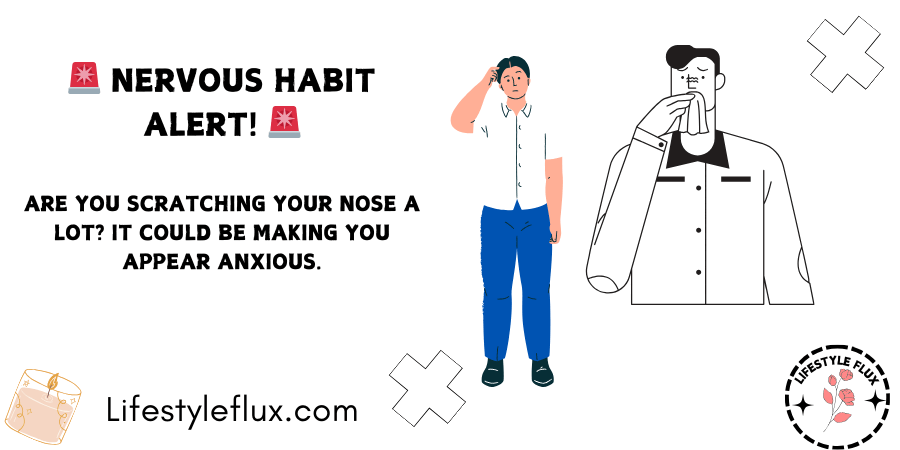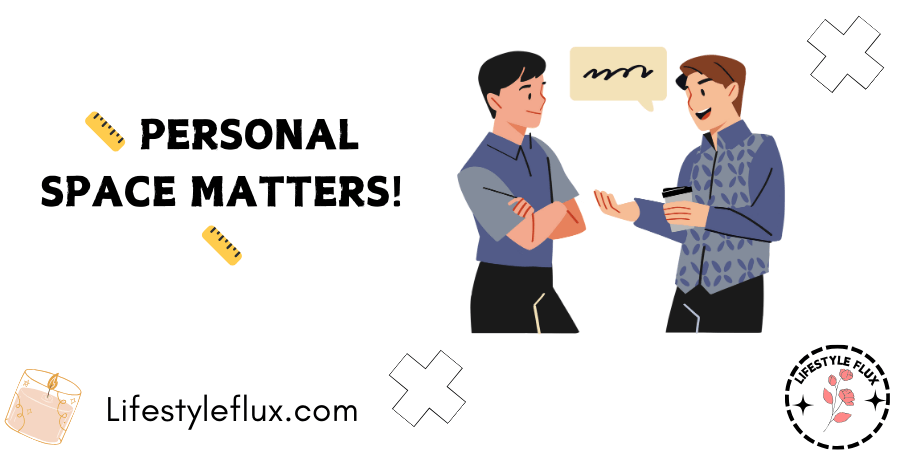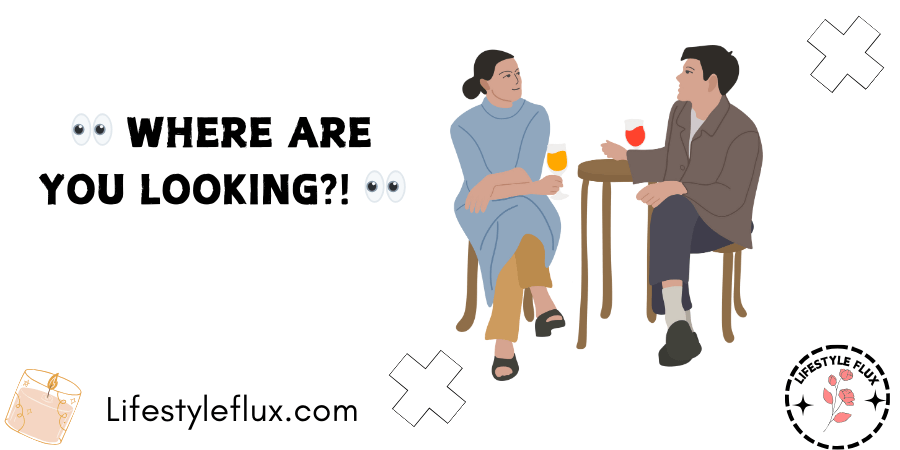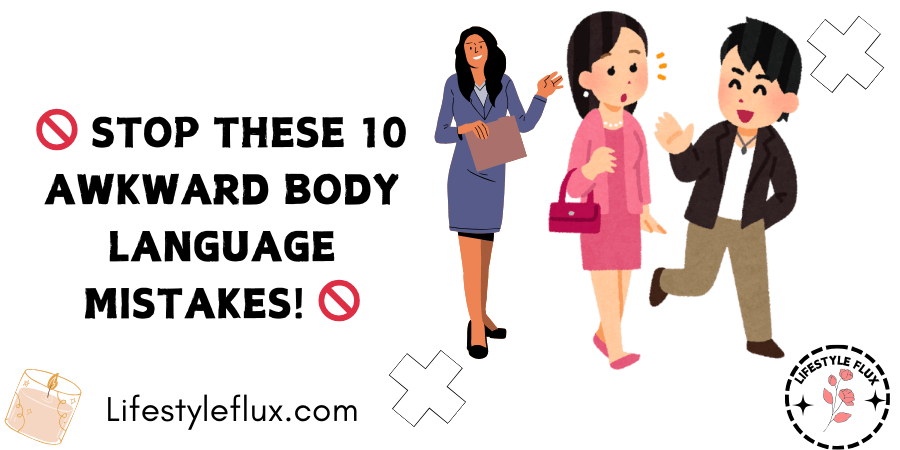Ever feel like people find you a little awkward? You might be giving off the wrong signals without even realizing it.
In 10 Body Language Mistakes Making You Look Awkward, we’re breaking down the unconscious habits that make conversations uncomfortable—and how to fix them before they ruin your first impression.
From nervous fidgeting to poorly timed gestures, these subtle cues can make you seem distracted, distant, or even unapproachable. But don’t worry—once you know what to look for, small tweaks can make a big difference.
Table of Contents
1. Scratching Your Nose
Rosy cheeks are a dead giveaway that you’re feeling nervous or awkward. But where does all that redness come from? When you’re feeling stressed, a sudden rush of blood fills up the vessels in your face.
It makes your head hot and, of course, turns your skin red. However, people can’t always tell when your cheeks are flushed. If you’re in a darker room, for example, you don’t have much to worry about—little changes in your skin color are almost impossible for anyone to see.

But rosy cheeks aren’t the only sign that you’re nervous. In fact, you’re probably using awkward body language that’s even more obvious. When all that blood rushes into your face, it creates extra pressure under your skin and makes your face really itchy.
Without realizing it, you might stand there scratching your cheeks or your nose over and over again. One or two scratches are pretty normal, but if you’re constantly reaching up to rub your nose, you’re going to make people feel awkward.
So, the next time your cheeks turn red or your nose feels tingly, keep your hands as far away from your face as you can.
2. The Growing Gap
Once you’ve started a conversation with someone, how far away from them should you stand? There really isn’t one right answer—everyone has their own personal preference.
Some people like to get up close and personal, while others will make sure that you’ve both got plenty of space to work with. But if you’re standing too far away, other people might find you awkward and uncomfortable to be around.
Creating a gap works a lot like crossing your arms over your chest—it’s a physical barrier that divides your space from theirs. While that extra space might keep your nerves under control, it has a negative effect on the way people perceive you.
Standing too far away makes you seem distant and aloof. It tells the world that you’d rather stay inside your personal bubble. You can usually fix this awkward body language by scooting closer as the conversation goes on.

If you gradually close the gap, it shows people that you’re trying to open up and bond with them on a deeper level. But what happens if the gap gets even larger?
Well, you’d be surprised how many people unconsciously back away as the conversation goes on. They start the conversation a few feet apart, and then five minutes later, they end up halfway across the room.
Now, obviously, this kind of thing throws people for a loop. They’ll think they did something wrong or scared you off, which makes the situation uncomfortable for everyone involved.
3. Frazzled Glances
Eye contact is one of the most powerful forms of body language, but it isn’t nearly as easy as it looks. It takes a lot of confidence to purposely look into someone else’s eyes, especially when you’re already feeling shy or nervous.
That’s why people go to such great lengths to avoid making eye contact. They’ll do all kinds of weird things, like staring at the floor or constantly looking at their hands.

But the worst thing you can do is try to look everywhere at the same time. Scattered glances will make anyone feel on edge. If you’re constantly looking side to side or up and down, people are going to wonder what you’re searching for.
They’ll think you’re distracted, annoyed, or just plain paranoid. So, even if you’re still working on making direct eye contact, don’t let your eyes wander too much.
4. Pushing Out Your Chin
Humans gather an incredible amount of information from every single part of the face. When you think about the most emotive body parts, what comes to mind?
Probably the eyes and the mouth, right? We just talked about how powerful eye contact can be, and everyone’s experienced the huge impact a smile or a frown can have.
But what about the rest of your face? What can you learn from less expressive body parts like your chin or jawline? You can learn a lot. For example, you tend to push out your chin when you’re feeling frustrated or anxious.
It stems from an excess of tension in your jaw. When you’re feeling stressed or restless, the muscles in your jaw tighten, pressing together your teeth and pushing your chin forward.
When people notice that tension in your jawline, it affects the way they perceive your mood. They assume you’re irritated, which obviously throws a wrench into the conversation.
To avoid looking uncomfortable, keep your jaw loose and your chin back. Yeah, I know it sounds like a small change, but when it comes to body language, even tiny adjustments can make a significant impact.
5. Unconscious Flinching
When you start talking to someone new, there’s one feeling you never want them to have: you never want anyone to think you’re afraid of them. As soon as fear enters the conversation, your dynamic will completely change.
They’ll feel confused and uncomfortable, you’ll get defensive, and the chances of forming an actual friendship become slim to none.
That’s why flinching is such a destructive form of body language. If you wince every time someone moves their hand or steps towards you, they’re going to think you’re scared.
Think about it—what else makes you flinch? Things like snakes, spiders, and monsters in horror movies. When something like that terrifies you, your fight-or-flight response kicks into high gear.
Your arms and legs move on their own, your eyes widen, and your body shrinks away. So, when you flinch while talking to someone, you’ve now placed them in the same category as snakes and spiders—and that’s not a place anybody wants to be.
6. Peeking Your Eyebrows
The eyebrows are another part of the face that doesn’t get enough recognition. A small change in the angle of your eyebrows can completely change your expression.
Imagine someone smiling with their eyebrows angled up—they’d look happy or maybe a little sympathetic. But what if they smile with their eyebrows angled down?
Suddenly, they look maniacal, like a supervillain watching their master plan unfold. So, how can your eyebrows turn normal body language into awkward body language?
When you’re worried or stressed, your eyebrows tend to get higher on your face. People will consistently think something’s wrong, even if you’re trying to act normal.
Luckily, there’s an easy fix: if you can’t stop your eyebrows from peaking, pair it with a little smile. That way, you’ll seem interested instead of anxious or uncomfortable.
7. Attachment to Your Phone
What’s the most frustrating thing someone can do in the middle of a conversation? Countless surveys have asked this same question, and one answer consistently tops the charts: few things are more annoying than someone who keeps checking their phone while you’re talking.
But why does this behavior bother us so much? Each time you check your phone, it’s like telling someone they don’t have your full attention. You’re basically saying the conversation just isn’t interesting or important to you anymore.
Obviously, that would make anyone feel awkward or annoyed. So, keep your phone in your pocket unless you’re waiting for a really important message. Your phone can wait.
8. Restless Limbs
Do you have trouble keeping your legs from shaking or your feet from tapping? Restless limbs are a very well-known sign of social anxiety. In fact, about 10% of the population compulsively moves their hands or feet when they’re feeling stressed.
Most of the time, your limbs move to release nervous energy. For example, you might tap your foot while taking a test to help yourself focus.
But in any social situation, that’s not what people are going to see. They’ll think you’re anxious or impatient—neither of which paints you in the most positive light.
Unfortunately, restless limbs are almost impossible to hide. Your legs make up a huge portion of your body, so if your legs don’t stop moving, people are going to notice.
The best thing you can do is distract them with other kinds of positive body language. Make eye contact, uncross your arms, and lean forward when they’re talking. If you show enough positivity, people won’t pay much attention to your restless legs.
9. Skulking
Lots of people hunch over or slouch when they stand, but some people have such bad posture that it actually hurts their image.
If you have awkward body language, you might do something called skulking—it’s when you lean your head down and forward as you walk, almost like you’re trying to shield your face.
This kind of body language really throws people off. Not only does it look strange, but it makes everyone think you’ve got something to hide.
10. Wild Gestures
Tons of people talk with their hands, and under the right circumstances, it adds emphasis and makes you seem more charismatic. But some people take basic hand gestures way too far.

If you swing your hands around wildly when you talk, you’re making the people around you feel uncomfortable. Because you’re not gesturing for any real reason; you’re just flailing your hands around.
Not only are these wild gestures super distracting, but they also make you look like a big bundle of nerves.
In other words, it’s perfectly fine to move your hands around when you want to make a point—make sure that you keep your gestures under control.
Conclusion:
Body language is a powerful tool—when used correctly. The way you stand, move, and even glance around a room can shape the way people perceive you.
Luckily, these awkward habits aren’t set in stone. A little awareness and a few adjustments can instantly boost your confidence and social presence. So, next time you catch yourself scratching your nose or backing away mid-conversation, take a breath, reset, and step into every interaction with purpose.
Sources:
https://health.usnews.com/health-news/health-wellness/articles/2015/11/23/the-science-of-awkwardness
https://www.inc.com/travis-bradberry/8-great-tricks-for-reading-peoples-body-language.html
https://www.psychologytoday.com/us/blog/spycatcher/200911/the-psychology-body-language
https://www.bustle.com/p/11-subtle-signs-someone-may-be-uncomfortable-around-you-7662695

Founder and CEO of Lifestyleflux.com, I bring years of expertise in self-improvement, wellness, and personal development to help you lead a happier, more balanced life. Through practical insights, eBooks, and consultations, I share actionable strategies rooted in experience and a passion for empowering others to unlock their full potential.

